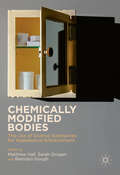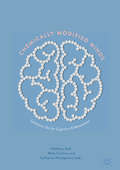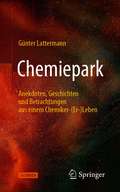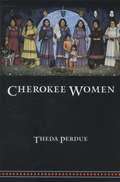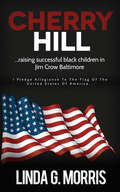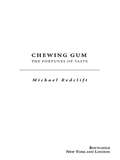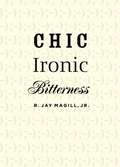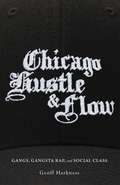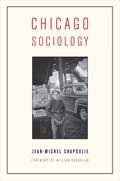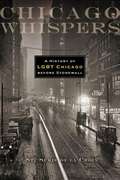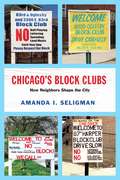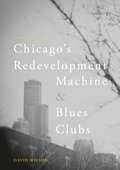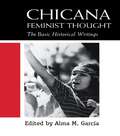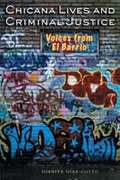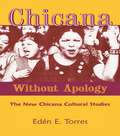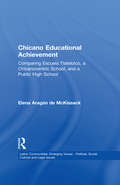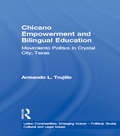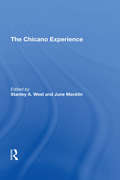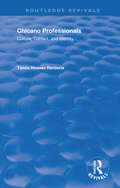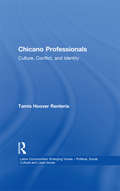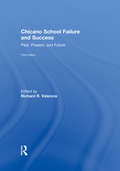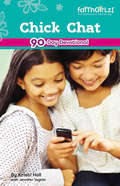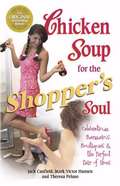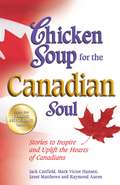- Table View
- List View
Chemically Modified Bodies: The Use of Diverse Substances for Appearance Enhancement
by Matthew Hall Sarah Grogan Brendan GoughThis innovative edited collection brings together leading international academics to explore the use of various non-prescription and prescription substances for the purpose of perceived body image enhancement. While studies on drug misuse to date have examined drug use in the context of sporting performance, addiction, and body image for particular groups such as bodybuilders, there has been little research that explores the wider use (and misuse) of legal and illegal drugs for body image development and weight loss. With medical sociology and social psychology at its core, this important volume shows the complex reasons behind the misuse of various medications, how these are connected to contemporary body image and appearance concerns, and why the known health risks and possibly harmful side effects do not act as deterrents.
Chemically Modified Minds: Substance Use for Cognitive Enhancement
by Matthew Hall Mark Forshaw Catharine MontgomeryThis innovative edited collection brings together leading international academics to explore the use of various non-prescription and prescription substances. From a psychosocial perspective, the authors discuss the complex reasons behind their adoption, the ways in which they are misused, and links between use and cognitive enhancement. While studies on substance use to date have examined the aetiology and effects in the context of sporting performance, addiction and recreational use, there has been little work which explores their wider misuse to improve cognitive enhancement.With medical sociology and social psychology at its core, this important volume shows the complex reasons behind the misuse of various substances, how these are connected to contemporary desire for increased mental performance, and why the potential health risks and possibly harmful side effects do not act as deterrents.
Chemiepark: Anekdoten, Geschichten und Betrachtungen aus einem Chemiker-(Er-)Leben
by Günter LattermannDieses Buch ist in zwei Teile aufgeteilt und beschreibt im Ersteren anhand von köstlichen Anekdoten und Geschichten mit teilweise berühmten Leuten mein Chemiker-(Er-)Leben. Im zweiten Teil diskutiere ich die vermeintlichen „zwei Kulturen“ von Geistes- und Naturwissenschaften, Imageprobleme der Chemie, ChemikerInnen, Kunststoffen/Plastik, sowie deren mögliche Bewältigung (Rationalität und Emotion) und die gegenwärtige Plastikmüllproblematik in Zusammenhang mit der Kunststoffgeschichte. Dieses Buch ist sowohl für Leute vom Fach, als auch Nichtfachleute geeignet.
Chemische Grundlagen der Geo- und Umweltwissenschaften
by Robin GillChemische Grundlagen sind die Basis für einen großen Teil der Geowissenschaften. Studierende der Geowissenschaften benötigen daher zunehmend ein solides Verständnis der chemischen Grundlagen, um ihr Studium erfolgreich zu absolvieren. Die erweiterte zweite Auflage dieses beliebten Lehrbuchs führt die Studenten in diese "georelevante" Chemie ein, die in demselben klaren und verständlichen Stil wie die Vorauflage präsentiert wird. Die neue Auflage wurde jedoch um den Bereich der Umweltgeowissenschaften erweitert und enthält ein neues Kapitel, in dem die Isotopengeochemie vorgestellt wird.Das Buch umfasst drei große, gegliederte Teile. Der erste (Kapitel 1-4) befasst sich mit der grundlegenden physikalischen Chemie geologischer Prozesse. Der zweite Teil (Kapitel 5-8) führt in die wellenmechanische Sicht auf das Atom ein und erklärt die verschiedenen Arten chemischer Bindungen, die den Materialien der Erde ihre vielfältigen und charakteristischen Eigenschaften verleihen. Die Schlusskapitel (9-11) geben einen Überblick über die geologisch relevanten Elemente und Isotope und erklären ihre Entstehung und ihre Häufigkeit im Kosmos und auf der Erde. Das Buch schließt mit einem umfangreichen Glossar von Begriffen; die Anhänge behandeln grundlegende Mathematik, erklären die grundlegende Lösungschemie und listen die chemischen Elemente und die im Buch verwendeten Symbole, Einheiten und Konstanten auf.Die Übersetzung wurde mit Hilfe von künstlicher Intelligenz (maschinelle Übersetzung durch den Service DeepL.com) angefertigt. Da die anschließende Überprüfung hauptsächlich im Hinblick auf inhaltliche Gesichtspunkte erfolgte, kann sich der Text des Buches stilistisch von einer konventionellen Übersetzung unterscheiden. Springer Nature arbeitet bei der Publikation von Büchern kontinuierlich mit innovativen Technologien, um die Arbeit der Autoren unterstützen.
Cherokee Women: Gender And Culture Change, 1700-1835
by Theda PerdueTheda Perdue examines the roles and responsibilities of Cherokee women during the eighteenth and nineteenth centuries, a time of intense cultural change. While building on the research of earlier historians, she develops a uniquely complex view of the effects of contact on Native gender relations, arguing that Cherokee conceptions of gender persisted long after contact. Maintaining traditional gender roles actually allowed Cherokee women and men to adapt to new circumstances and adopt new industries and practices.
Cherry Hill: Raising Successful Black Children in Jim Crow Baltimore
by Linda G. MorrisBefore Opie lived in Mayberry, Beaver and Wally in Mayfield, and Betty, Bud and Kathy in Springfield, there were thousands of little Black children experiencing the same quality of life in Cherry Hill, a post WWII planned suburban community containing a public housing project on a southeastern peninsula of Baltimore City. These children had a sense of being loved, being free, being safe, and above all, having the space they needed to stretch out and enjoy small town living. They could play all day with their friends, skate and ride their bikes all over town, and chase the ice cream man’s truck, with the admonishment to be home by the time the streetlights came on. The author was one of those children, and she rallied sixty or so of her Cherry Hill contemporaries to share what life was like for them in what they know to be a special place and time.
Chewing Gum: The Fortunes of Taste
by Michael RedcliftIn Chewing Gum, Michael Redclift deftly chronicles the growing popularity of gum in the U.S. alongside a fascinating history of peasant revolution led by charismatic Indians in the jungles of southern Mexico.
Chic Ironic Bitterness
by R. Jay Magill Jr.The events of 9/11 had many pundits on the left and right scrambling to declare an end to the Age of Irony. But six years on, we're as ironic as ever. From The Simpsons and Borat to The Daily Show and The Colbert Report, the ironic worldview measures out a certain cosmopolitan distance, keeping hypocrisy and threats to personal integrity at bay. Chic Ironic Bitterness is a defense of this detachment, an attitude that helps us preserve values such as authenticity, sincerity, and seriousness that might otherwise be lost in a world filled with spin, marketing, and jargon. And it is an effective counterweight to the prevailing conservative view that irony is the first step toward cynicism and the breakdown of Western culture.
Chicago Hustle and Flow: Gangs, Gangsta Rap, and Social Class
by Geoff HarknessOn September 4, 2012, Joseph Coleman, an eighteen-year-old aspiring gangsta rapper, was gunned down in the Englewood neighborhood of Chicago. Police immediately began investigating the connections between Coleman&’s murder and an online war of words and music he was having with another Chicago rapper in a rival gang. In Chicago Hustle and Flow, Geoff Harkness points out how common this type of incident can be when rap groups form as extensions of gangs. Gangs and rap music, he argues, can be a deadly combination. Set in one of the largest underground music scenes in the nation, this book takes readers into the heart of gangsta rap culture in Chicago. From the electric buzz of nightclubs to the sights and sounds of bedroom recording studios, Harkness presents gripping accounts of the lives, beliefs, and ambitions of the gang members and rappers with whom he spent six years. A music genre obsessed with authenticity, gangsta rap promised those from crime-infested neighborhoods a ticket out of poverty. But while firsthand experiences with gangs and crime gave rappers a leg up, it also meant carrying weapons and traveling collectively for protection. Street gangs serve as a fan base and provide protection to rappers who bring in income and help to recruit for the gang. In examining this symbiotic relationship, Chicago Hustle and Flow ultimately illustrates how class stratification creates and maintains inequalities, even at the level of a local rap-music scene.
Chicago Sociology
by Jean-Michel ChapoulieKnown for its pioneering studies of urban life, immigration, and criminality using the “city as laboratory,” the so-called Chicago school of sociology has been a dominant presence in American social science since it emerged around the University of Chicago in the early decades of the twentieth century. Canonical figures such as Robert Park, Everett Hughes, Howard S. Becker, and Erving Goffman established foundational principles of how to conduct social research.This groundbreaking book on the development and influence of the Chicago tradition, first published in 2001, became an immediate classic in France, where Chicago sociology has exerted significant appeal. Drawing on deep archival research and interviews with members of the tradition, Jean-Michel Chapoulie interrogates evidence with a historian’s eye and recognizes the profound effects that culture, society, and the economy have on individuals and institutions. His study is a fine-grained and panoramic portrait of the complex and interlocking factors that gave rise to the research interests and methodologies that characterized the Chicago tradition in the 1920s and that contributed to rises and falls in its predominance in American sociology over the following decades. Now revised and available for the first time in English, Chicago Sociology provides a unique perspective on the history of social science in the twentieth century. A foreword by William Kornblum places Chapoulie’s work in context and addresses recent critical challenges to the Chicago school and its origins.
Chicago Whispers: A History of LGBT Chicago Before Stonewall
by St. Sukie de la CroixChicago Whispers illuminates a colorful and vibrant record of lesbian, gay, bisexual, and transgendered people who lived and loved in Chicago from the city’s beginnings in the 1670s as a fur-trading post to the end of the 1960s. Journalist St. Sukie de la Croix, drawing on years of archival research and personal interviews, reclaims Chicago’s LGBT past that had been forgotten, suppressed, or overlooked. Included here are Jane Addams, the pioneer of American social work; blues legend Ma Rainey, who recorded “Sissy Blues” in Chicago in 1926; commercial artist J. C. Leyendecker, who used his lover as the model for “The Arrow Collar Man” advertisements; and celebrated playwright Lorraine Hansberry, author of A Raisin in the Sun. Here, too, are accounts of vice dens during the Civil War and classy gentlemen’s clubs; the wild and gaudy First Ward Ball that was held annually from 1896 to 1908; gender-crossing performers in cabarets and at carnival sideshows; rights activists like Henry Gerber in the 1920s; authors of lesbian pulp novels and publishers of “physique magazines”; and evidence of thousands of nameless queer Chicagoans who worked as artists and musicians, in the factories, offices, and shops, at theaters and in hotels. Chicago Whispers offers a diverse collection of alternately hip and heart-wrenching accounts that crackle with vitality.
Chicago's Block Clubs: How Neighbors Shape the City
by Amanda I. SeligmanWhat do you do if your alley is strewn with garbage after the sanitation truck comes through? Or if you're tired of the rowdy teenagers next door keeping you up all night? Is there a vacant lot on your block accumulating weeds, needles, and litter? For a century, Chicagoans have joined block clubs to address problems like these that make daily life in the city a nuisance. When neighbors work together in block clubs, playgrounds get built, local crime is monitored, streets are cleaned up, and every summer is marked by the festivities of day-long block parties. In Chicago's Block Clubs, Amanda I. Seligman uncovers the history of the block club in Chicago--from its origins in the Urban League in the early 1900s through to the Chicago Police Department's twenty-first-century community policing program. Recognizing that many neighborhood problems are too big for one resident to handle--but too small for the city to keep up with--city residents have for more than a century created clubs to establish and maintain their neighborhood's particular social dynamics, quality of life, and appearance. Omnipresent yet evanescent, block clubs are sometimes the major outlets for community organizing in the city--especially in neighborhoods otherwise lacking in political strength and clout. Drawing on the stories of hundreds of these groups from across the city, Seligman vividly illustrates what neighbors can--and cannot--accomplish when they work together.
Chicago’s Redevelopment Machine and Blues Clubs
by David WilsonThis book examines the conflict surrounding the latest redevelopment frontier in Chicago: the city's South Side blues clubs and blocks. Like Chicago, cities such as Cleveland, St. Louis, Boston, Washington D. C. , Indianapolis, Milwaukee, and Philadelphia are experiencing a new redevelopment machine: one of tyrannizing and fear. Its actors are adroit at working via the creation of fear to "terror-redevelop" in these historically neglected neighborhoods. The book also discusses the powerful race and class-based politics in Chicago's blues clubs that resist such change. A "leisure as resistance" framework represents the latest innovative form of opposition to the transformation of these historic sites.
Chicana Feminist Thought: The Basic Historical Writings
by Alma M. GarcíaChicana Feminist Thought brings together the voices of Chicana poets, writers, and activists who reflect upon the Chicana Feminist Movement that began in the late 1960s. With energy and passion, this anthology of writings documents the personal and collective political struggles of Chicana feminists.
Chicana Lives and Criminal Justice: Voices From El Barrio
by Juanita Diaz-CottoThe author uses oral histories to chronicle the lives of 24 Chicana pintas (prisoners/former prisoners) repeatedly arrested and incarcerated for non-violent, low-level economic and drug-related crimes.
Chicana Without Apology: The New Chicana Cultural Studies
by Eden E. TorresBy approaching Chicana/o issues from the frames of feminism, social activism, and cultural studies, and by considering both lived experience and the latest research, Torres offers a more comprehensive understanding of current Chicana life. Through compelling prose, Torres masterfully weaves her own story as a first-generation Mexican American with interviews with activists and other Mexican-American women to document the present fight for social justice and the struggles of living between two worlds.
Chicano Educational Achievement: Comparing Escuela Tlatelolco, A Chicanocentric School, and a Public High School (Latino Communities: Emerging Voices - Political, Social, Cultural and Legal Issues)
by Elena Aragon McKissackFirst published in 2000. Routledge is an imprint of Taylor & Francis, an informa company.
Chicano Empowerment and Bilingual Education: Movimiento Politics in Crystal City, Texas (Latino Communities: Emerging Voices - Political, Social, Cultural and Legal Issues)
by Armando L. TrujilloFirst published in 1999. Routledge is an imprint of Taylor & Francis, an informa company.
Chicano Experience
by Stanley A. West June MacklinThe past decade has seen a renewed interest in ethnicity by people in search of their own identities, as well as by writers and scholars from every discipline. But despite the contagion of ethnic aEURO fever,aEURO the Chicano culture is neither widely known nor appreciated in the United States. The authors of this book attempt to close the gap in current knowledge. Their purpose is fourfold: (1) to add to the knowledge of Chicano communities; (2) to add to the knowledge and understanding of how Mexican Americans have adapted in various urban areas; (3) to present descriptions and analyses of communities in the Midwest, where the presence of Mexican Americans has been more typically neglected; and (4) to bring an anthropological approach to the understanding of this second-largest minority group in the United States.
Chicano Professionals: Culture, Conflict, and Identity
by Tamis Hoover RenteriaFirst published in 1998. Writing about Chicano professionals in Los Angeles proves timely for many reasons. Anthropologists now venture into the ethnic borderlands of their own western countries rather than encroach on the flexing ethnicities of the third world as they have traditionally done. The story of this ethnic elite begins in the 1960’s and 1970’s when Mexican American students from blue-collar backgrounds first entered California colleges and universities in significant numbers. This generation of Mexican American students is important, however, not merely for its increased numbers, but rather for the culture it created, the culture of "Chicanismo", the culture of the nationalist Chicano Movement.
Chicano Professionals: Culture, Conflict, and Identity (Latino Communities: Emerging Voices - Political, Social, Cultural and Legal Issues)
by Tamis Hoover RenteriaFirst published in 1998. Routledge is an imprint of Taylor & Francis, an informa company.
Chicano School Failure and Success: Past, Present, and Future
by Richard R. ValenciaThe third edition of the best selling collection, Chicano School Failure and Success presents a complete and comprehensive review of the multiple and complex issues affecting Chicano students today. Richly informative and accessibly written, this edition includes completely revised and updated chapters that incorporate recent scholarship and research on the current realities of the Chicano school experience. It features four entirely new chapters on important topics such as la Chicana, two way dual language education, higher education, and gifted Chicano students. Contributors to this edition include experts in fields ranging from higher education, bilingual education, special education, gifted education, educational psychology, and anthropology. In order to capture the broad nature of Chicano school failure and success, contributors provide an in-depth look at topics as diverse as Chicano student dropout rates, the relationship between Chicano families and schools, and the impact of standards-based school reform and deficit thinking on Chicano student achievement. Committed to understanding the plight and improvement of schooling for Chicanos, this timely new edition addresses all the latest issues in Chicano education and will be a valued resource for students, educators, researchers, policy makers, and community activists alike.
Chick Chat
by Kristi HollWhat girl doesn't like a nice cozy chat with a friend-especially a friend who understands everything about her? In Chick Chat, you'll learn how to build that heart-to-heart connection with the One who loves you best. Each devotion brings the Bible right into your world and offers lots to learn and think about-from the values that will be good for a lifetime to the things you can do to survive every day. Faithgirlz!"--Inner Beauty, Outward Faith Through imaginative and innovative products, Zonderkidz is feeding young souls.
Chicken Soup For The Shopper's Soul: Celebrating Bargains, Boutiques And The Perfect Pair Of Shoes
by Mark Victor Hansen Jack L. Canfield Theresa PelusoShopaholics Unite! You know it when you find it: the perfect black dress, the welcome mat for your first home, the yellow bunny sheets for your best friend's baby shower, the laundry basket your nephew will never use in college. Whatever the mission, shopping for yourself and others marks life's milestones, celebrates your passions and expresses your individuality. And most important, shopping is just plain fun! Whether your preferred stomping ground is an antique shop or a mega mall, a bargain basement or a boutique, a flea market or Fifth Avenue, you'll be thoroughly entertained, inspired and validated by the true-life shopping adventures of like-minded people like you? People who freely admit they were Born to Shop? And who never cease to find fulfillment, enjoyment and a few great buys while doing it. Chicken Soup for the Shopper's Soul is the ultimate celebration of the ultimate pastime. Let the bargains begin!
Chicken Soup for the Canadian Soul: Stories to Inspire and Uplift the Hearts of Canadians
by Jack Canfield Mark Victor Hansen Raymond Aaron Janet MatthewsWearing poppies on your lapel during the month of November. Enjoying local fiddlers playing music on Cape Breton Island. Cheering your favorite team on during Hockey Night. Swatting mosquitoes in Muskoka on the first long weekend in May. Driving the Trans-Canada Highway. Questioning why the ABC song ends in "z" and not "zed. " All these things are distinctly Canadian and now there's another one more: Chicken Soup for the Canadian Soul. Written by fellow Canadians from Cape Breton Island to Prince Edward Island, from Montreal to Vancouver, this book reveals the people, the history and the special moments that give Canada such a distinctive charm and character. With chapters including: On Being Canadian, Living Your Dream, Overcoming Obstacles, On Love, On Kindness, and Making a Difference, these stories weave a rich tapestry of life from the people who call Canada home. Notable stories include: hockey player Paul Henderson's "Goal of the Century," Chief Dan George's recounting of his great land, Marilyn Bell DiLascio's historic 1954 Lake Ontario swim, cartoonist Lynn Johnston's delightful story of an encounter with Wayne Gretzky, and journalist Sally Armstrong's details of Princess Diana's first trip to Canada. Like hearing a heartfelt version of "O, Canada!" this book will instill renewed pride and patriotism in a well-deserving country and its people.
